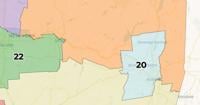The newest congressional map that a bipartisan commission approved by a 9-1 margin is a win for “small-‘d’ democratic participation in the state of New York.”
That’s how Ken Jenkins, the New York State Independent Redistricting commission’s Democratic chairman, phrased it to the New York Times this week.
No doubt, Jenkins is motivated to defend the work of a body he helped lead.
But he’s also correct.
The New York congressional map unveiled Thursday, which is largely unchanged from the current map, is a clear victory for the democratic process.
In turn, capital 'd' Democrats in the New York State Legislature would be wrongheaded to challenge it.
I understand the temptation that State Senate Majority Leader Andrea Stewart-Cousins and Assembly Speaker Carl Heastie may feel, especially as they face pressure from national party figures like House Democratic Leader Hakeem Jeffries. And I get the argument that says if states with Republican leadership are willing to unapologetically approve partisan maps, shouldn’t New York leaders draw their own battle lines, and fight fire with fire?
“I think we need to wrest control of districting away from political parties,” Union College political science professor Zoe Oxley told me. “I realize that sounds idealistic. However, there have been moves in the past 10, 20 years that have taken districting out of the hands of the parties – or somewhat out of the hands of the parties – to try to move toward non-partisan districting.”
That’s exactly what New York’s long-drawn-out mapmaking was supposed to be about.
The whole thing started with small “d” democracy in 2014, when voters approved the creation of a bipartisan commission as part of changes to the state’s constitution.
Yet, inevitably, politics – and politicians – intervened.
In 2022, the panel couldn’t come to consensus on a map after failing to overcome partisan disagreement.
That’s when the remapping process lost its way.
The Democratic-controlled state Legislature took over the mapmaking, approving congressional district lines that were so nakedly partisan that the map was easily exposed as being heavily gerrymandered during a Republican legal challenge.
As a result, a special master created the current map used in the 2022 midterm elections, when Republicans flipped four House seats – a stinging defeat that sent New York Democrats back to the drawing board.
When the state’s highest court held up a Democratic legal challenge to the special master’s map, the commission was once again enlisted in December to come up with new lines.
This time, the 10-person body overcame the partisan divide, overwhelmingly approving the latest map.
“It's a message,” Oxley said. “I think it's an important message.”
And it’s a message that capital “d” Democrats should heed as state party leaders weigh whether to approve or challenge the proposed boundaries, which could be in place for the remainder of the decade.
Sure, the new map isn’t as favorable to Democrats as a gerrymandered version they’d draw themselves. But it still puts them in position to flip one seat in the Syracuse area.
Plus, no one will be served by another election in which challenges to boundaries, and ever-shifting lines, make it so Congressional candidates don’t even know what terrain they are running to lead.
With Tom Suozzi’s decisive victory earlier this week in New York’s 3rd Congressional District – unchanged in the proposed maps – Democrats should realize they can win competitive races with sensible solutions to major issues such as immigration. The party’s focus should be on crafting a message that can appeal to some voters across the aisle rather than on redrawing maps with partisan lines.
The proposed map may not be perfect for Democrats, but it’s definitely progress for democracy.
“The voters passed this change to the state constitution to take districting out of partisan hands. That was the intent,” Oxley said. “So if the Democratic Legislature introduces maps that are strongly or even somewhat favoring Democratic voters in the state, it's clearly violating the constitutional mandate as given by the voters.”
In other words, another fight over the map would essentially be an attack on democracy.
Legislators are due back in Albany Feb. 26, so we’ll likely find out then – if not earlier – what state Democratic leaders want to do. Are they willing to resist their own urges to try to take advantage of a judiciary that's likely to be more sympathetic to their cause? Are they able to to stand up to national pressure and uphold the democratic process?
“I know what they should do, but I don’t dare predict that one,” Oxley said.
After all, betting on politicians to do the right thing is not often a winning proposition.









